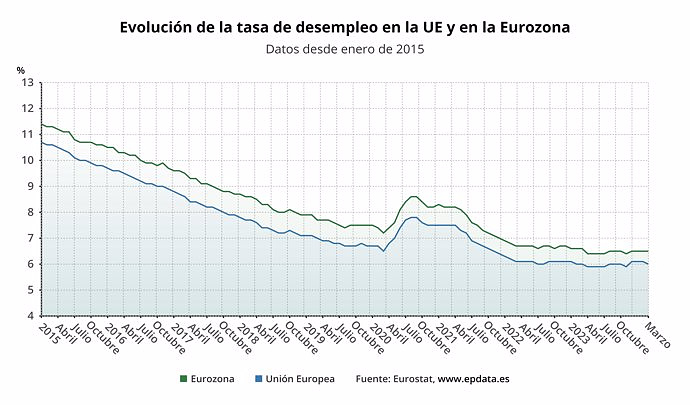BRUSSELS, April 23 (EUROPA PRESS) -
This Tuesday, the plenary session of the European Parliament adopted the new EU fiscal rules that, after four years frozen by the pandemic, will once again limit the debt and deficit of the Member States, although in a more flexible way and adapted to the situation by country.
The European Parliament has given the green light to the preventive component of the new fiscal framework with 367 votes in favor, 161 against and 69 abstentions, which was previously agreed with the Council, which plans to endorse the text next Monday.
The other two files of which the reform is made up, the regulation on the corrective arm and the directive on the requirements for the budgetary frameworks of the Member States, only required that the European Parliament be consulted, which has also approved them by 368 votes in favor, 166 against and 64 abstentions, and 359 votes in favor, 166 against and 61 abstentions, respectively.
The objective of this reform is to reduce debt ratios and deficits in a gradual, realistic, sustained and growth-friendly manner, while protecting reforms and investment in strategic areas such as digital, green, social or defending. Furthermore, the new framework will provide adequate scope for countercyclical policies and address macroeconomic imbalances.
"Exactly one year ago the Commission presented its proposals to reform our fiscal rules," recalled the European Commissioner for Economy, Paolo Gentiloni, after learning the result of the vote on the review, which will allow "correcting such rigid rules that were often not applied.
Aware that the new regulation "is not perfect" and that it "barely reduces complexity", the Italian commissioner highlighted that "it is unequivocally better than the current regulations" because it "strengthens incentives for public investment, establishes a credible path for the necessary debt reduction, ensures that Member States take responsibility for their fiscal policies and gives greater prominence to social aspects and climate considerations.
Each Member State will have to present its first national plans before September 20, 2024, while the Commission, for its part, will present a 'reference trajectory' (previously called 'technical trajectory') to countries where public debt exceeds the 60% of the gross domestic product (GDP) or where the public deficit exceeds 3% of GDP, as is the case of Spain.
The baseline path will indicate how Member States can ensure that, at the end of a four-year fiscal adjustment period, public debt is on a plausible downward trajectory or remains at prudent levels over the medium term.
Furthermore, a Member State may request the submission of a revised national plan if there are objective circumstances that prevent its implementation, even if there is a change of government.
Based on the Commission's reference trajectory, EU countries will outline their fiscal adjustment, expressed in net spending trajectories in their national medium-term fiscal structural plans, which must be approved by the Council.
The new rules will further encourage structural reforms and public investments for sustainability and growth and Member States will be able to request an extension of the fiscal adjustment period from four years to a maximum of seven years, if they carry out certain reforms and investments that improve resilience and growth potential and support fiscal sustainability and address common EU priorities.
These include achieving a just, green and digital transition, ensuring energy security, strengthening social and economic resilience and, where necessary, developing defense capabilities.
Countries with excessive debt will be subject to safeguard rules that will require them, among other things, to reduce their debt by an average of 1% per year if they exceed 90% of GDP, and by 0.5% per year on average if their debt is between 60% and 90% of GDP, less restrictive provisions than the current requirement that each country must reduce debt annually by 1/20 of the excess above 60%.
If a country's deficit exceeds 3% of GDP, the requirement will be to reduce it during periods of growth to a level of 1.5% of GDP, in order to create a spending cushion for difficult economic conditions. Other numerical benchmarks for how much the deficit should be reduced per year will also apply.
A country with excess debt will not be required to reduce it to less than 60% at the end of the plan's period of years, but must have debt that is considered to be on a "plausible downward trajectory."

 Exploring Cardano: Inner Workings and Advantages of this Cryptocurrency
Exploring Cardano: Inner Workings and Advantages of this Cryptocurrency Seville.- Economy.- Innova.- STSA inaugurates its new painting and sealing hangar in San Pablo, for 18 million
Seville.- Economy.- Innova.- STSA inaugurates its new painting and sealing hangar in San Pablo, for 18 million Innova.- More than 300 volunteers join the Andalucía Compromiso Digital network in one month to facilitate access to ICT
Innova.- More than 300 volunteers join the Andalucía Compromiso Digital network in one month to facilitate access to ICT Innova.-AMP.- Ayesa acquires 51% of Sadiel, which will create new technological engineering products and expand markets
Innova.-AMP.- Ayesa acquires 51% of Sadiel, which will create new technological engineering products and expand markets A total of 19,887 migrants have arrived in Spain so far this year, 190% more, 15,982 of them in the Canary Islands
A total of 19,887 migrants have arrived in Spain so far this year, 190% more, 15,982 of them in the Canary Islands C-LM, Extremadura or Madrid, among the CC.AA that announce the creation of Bullfighting Awards after the suppression of Culture
C-LM, Extremadura or Madrid, among the CC.AA that announce the creation of Bullfighting Awards after the suppression of Culture Urtasun faces criticism for suppressing the Bullfighting Prize: "I think they represent a minority"
Urtasun faces criticism for suppressing the Bullfighting Prize: "I think they represent a minority" Sánchez charges against the PP and Vox governments after the UN report and warns that he will defend democratic memory
Sánchez charges against the PP and Vox governments after the UN report and warns that he will defend democratic memory How Blockchain in being used to shape the future
How Blockchain in being used to shape the future Not just BTC and ETH: Here Are Some More Interesting Coins Worth Focusing on
Not just BTC and ETH: Here Are Some More Interesting Coins Worth Focusing on Faraday UPV presents the 'Origin' rocket to exceed 10 km of flight: "It is the beginning of the journey to space"
Faraday UPV presents the 'Origin' rocket to exceed 10 km of flight: "It is the beginning of the journey to space" The Generalitat calls for aid worth 4 million to promote innovation projects in municipalities
The Generalitat calls for aid worth 4 million to promote innovation projects in municipalities UPV students design an app that helps improve the ventilation of homes in the face of high temperatures
UPV students design an app that helps improve the ventilation of homes in the face of high temperatures Ivace and promotes a less invasive device for the early detection of prostate cancer
Ivace and promotes a less invasive device for the early detection of prostate cancer A million people demonstrate in France against Macron's pension reform
A million people demonstrate in France against Macron's pension reform Russia launches several missiles against "critical infrastructure" in the city of Zaporizhia
Russia launches several missiles against "critical infrastructure" in the city of Zaporizhia A "procession" remembers the dead of the Calabria shipwreck as bodies continue to wash up on the shore
A "procession" remembers the dead of the Calabria shipwreck as bodies continue to wash up on the shore Prison sentences handed down for three prominent Hong Kong pro-democracy activists
Prison sentences handed down for three prominent Hong Kong pro-democracy activists ETH continues to leave trading platforms, Ethereum balance on exchanges lowest in 3 years
ETH continues to leave trading platforms, Ethereum balance on exchanges lowest in 3 years Investors invest $450 million in Consensys, Ethereum incubator now valued at $7 billion
Investors invest $450 million in Consensys, Ethereum incubator now valued at $7 billion Alchemy Integrates Ethereum L2 Product Starknet to Enhance Web3 Scalability at a Price 100x Lower Than L1 Fees
Alchemy Integrates Ethereum L2 Product Starknet to Enhance Web3 Scalability at a Price 100x Lower Than L1 Fees Mining Report: Bitcoin's Electricity Consumption Declines by 25% in Q1 2022
Mining Report: Bitcoin's Electricity Consumption Declines by 25% in Q1 2022 Oil-to-Bitcoin Mining Firm Crusoe Energy Systems Raised $505 Million
Oil-to-Bitcoin Mining Firm Crusoe Energy Systems Raised $505 Million Microbt reveals the latest Bitcoin mining rigs -- Machines produce up to 126 TH/s with custom 5nm chip design
Microbt reveals the latest Bitcoin mining rigs -- Machines produce up to 126 TH/s with custom 5nm chip design Bitcoin's Mining Difficulty Hits a Lifetime High, With More Than 90% of BTC Supply Issued
Bitcoin's Mining Difficulty Hits a Lifetime High, With More Than 90% of BTC Supply Issued The Biggest Movers are Near, EOS, and RUNE during Friday's Selloff
The Biggest Movers are Near, EOS, and RUNE during Friday's Selloff Global Markets Spooked by a Hawkish Fed and Covid, Stocks and Crypto Gain After Musk Buys Twitter
Global Markets Spooked by a Hawkish Fed and Covid, Stocks and Crypto Gain After Musk Buys Twitter Bitso to offset carbon emissions from the Trading Platform's ERC20, ETH, and BTC Transactions
Bitso to offset carbon emissions from the Trading Platform's ERC20, ETH, and BTC Transactions Draftkings Announces 2022 College Hoops NFT Selection for March Madness
Draftkings Announces 2022 College Hoops NFT Selection for March Madness























